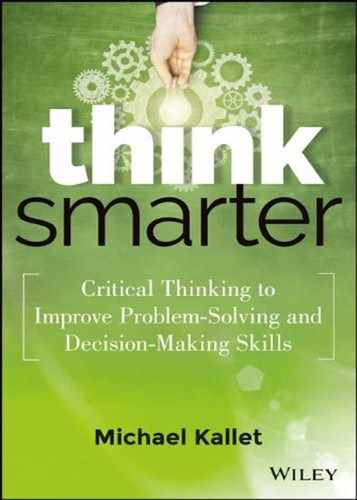34 Summary of Decisions
Taking Action
Deciding is the last step before executing your conclusion; it's the go or no-go. If a decision of go is made, people get to work and execution begins. A decision is made by identifying the decision maker (who), ensuring there's a need to make a decision, determining when it will be made and, most important, identifying the criteria because if met, it's a go. Risk is a key criterion involved in all of this.
We can make decisions quickly, because we've done almost all the work during the steps of clarity and conclusions. If you find yourself having difficulty in getting a decision made, one of the preceding factors isn't clear, or you haven't reached a definitive conclusion yet. Decisions are not “Should I buy the blue one or the red one?” They are “I've concluded to buy the red one; should I now buy it or not?” If you're still trying to figure out what to do, then go back to conclusions.
You may have heard of someone second-guessing a decision; you probably have done it yourself. This happens when you rethink a decision after you've made it and occurs most often when the criteria for the decision weren't well thought out. After making the decision, the decision maker thinks about it a little more and uncovers another criterion that brings to question the go or no-go call. You can avoid this by vetting and talking about the criteria.
Getting Started
Consider the following questions and advice when you're looking for a decision:
- Am I certain who the decision maker is?
- Does the decision maker know he or she is the decision maker?
- Can I articulate the business need to make a decision?
- What's the date that the decision must be made by? Look for reasons to make it a must, such as time dependence. If the decision to get on the train isn't made by the time the train leaves, then the no-action, no-go decision is automatically made.
- Avoid the no-decision decision. This is the automatic no-go, because an opportunity has come and gone and no action has been taken.
- The decision maker will have criteria he or she uses to evaluate the go or no-go. Help the decision maker write down what the criteria are.
- Practice reviewing the risk factors. See how you weigh these factors. When the decision maker begins to contemplate risk, you'll be prepared to have that conversation.
Are We Done Yet?
You're clear, you've reached a conclusion on how to solve your headscratcher, and now a decision has been made to move forward (go). If we define done as “critically thinking about a headscratcher from clarity through a decision,” then yes—you are done. However, there are a few caveats to being done—sorry!
You made assumptions back in the conclusions phase. It would be wise while executing your solution to check periodically to ensure that those assumptions are still good ones. If they turn out to be invalid, then your conclusion might not be a good one, and you might need to revisit your subsequent decision to go. For example, you concluded to expand your business to additional states where you are licensed and your competition is not. Because it would take your competition five years to get a license, you'd enjoy a nice advantage for several years. You made the decision to go, and you've started negotiating lease agreements. However, you just read an announcement (observation) that your competition has been acquired. Its new parent company is already licensed in these new states and is excited to expand as well. This new information just invalidated your assumption and shook your confidence in your conclusion. The actions you decided on are no longer going to yield the benefits as promised by those who persuaded you. You slow the train and temporarily halt the project so that you can revisit the decision that you founded on a conclusion whose premise just became weak.
Decisions move the ball forward. Although there's no guarantee you'll never have to backtrack, critical thinking will maximize the probability that you'll make decisive, quality decisions that will yield successful results.
